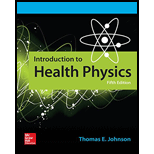
Concept explainers
(a)
The linear, mass and atomic attenuation coefficient.
(a)
Explanation of Solution
Given:
Density of lead,
Formula Used:
The attenuation of gamma ray can be described as,
Where,
Calculation:
The attenuation of gamma ray can be described as,
As intensity observed initially is 1000. So,
For
For
For
For
For
For
For
For
So, mean is,
The mass attenuation is given by,
The mass of the lead per unit volume is,
So, mass of each atom is,
Thus, number of atoms per unit volume is,
So, atomic attenuation coefficient is,
Conclusion:
The linear, mass and atomic attenuation coefficient are,
(b)
The energy of the gamma rays.
(b)
Explanation of Solution
The mass attenuation coefficient is 0.055 cm2/g.
Total mass attenuation coefficient 0.0569 cm2/g is close to calculated in part (a) and this corresponds to a value of
Thus, the energy corresponding to it is,
Conclusion:
The energy of gamma rays is
Want to see more full solutions like this?
Chapter 5 Solutions
Introduction To Health Physics
- (a) Show that if you assume the average nucleus is spherical with a radius r=r0A1/3, and with a mass at A u, then its density is independent at A. (b) Calculate that density in u/fm3 and kg/m3, and compare your results with those found in Example 31.1 for 56Fe.arrow_forwardIridium-192, a beta emitter, is used in medicine to treat certain cancers. The 192Ir is used as a wire and inserted near the tumor for a given amount of time and then removed. The 192Ir wire is coated with pure platinum, and is sold by diameter and amount of radiation emitted. One type of wire sold is 221 mm long, has a linear apparent activity of 30–130 MBq/cm, an active diameter (which is the iridium-192) of 0.1 mm, and an outer diameter (the platinum) of 0.3 mm. (a) How much 192Ir is in the wire if the apparent activity is 99 MBq/cm?Enter your answer in scientific notation: (b) If the wire is placed in the tumor for 60 hours, how much radiation is absorbed by the tumor?arrow_forwardIf you start with 7.0×1010I7.0×1010I-131 atoms, how many are left after approximately 1 month? II-131 has a half-life of 8.0 days.arrow_forward
- An alpha particle looses all of its energy in a gas and produces 15000 ions pair.If energy needed to produce one ion pair is 30ev.calculate the energy of alpha particle?arrow_forwardBy using Beta function, the integral V tan(0) d0 is equal toarrow_forwardThe linear absorption coefficient for 5-MeV gamma rays in lead is 78 m-1. Find the thickness of lead required to reduce by one- fourth the intensity of beam of such gamma rays. O A. 8.9 mm O B. 17.8 mm OC. 3.7 mm OD. 1.9 mm O E. 7.4 mmarrow_forward
- 1.86 O Hl 20% | 2:39 PM K/s iv. What exposure time is required for an equivalent dose of 200 rem? B. A laser with power output of 2.0 mW at a wavelength of 400 nm is projected onto a Calcium metal. The binding energy is 2.31 ev. i. How many electrons per second are ejected? i. What power is carried away by the electrons? C. A hypodermic needle of diameter 1.19 mm and length 50 mm is used to withdraw blood from a patient? How long would it take for 500 ml of blood to be taken? Assume blood viscosity of 0.0027 Pa.s and a pressure in the vein of 1.900 Pa. D. A person with lymphoma receives a dose of 35 gray in the form of gamma radiation during grams of cancerous lymphatic tissue. course of radiotherapy. Most of this dose is absorbed in 18 i. How much energy is absorbed by the cancerous tissue? If this treatment consists of five 15-minute sessions per week over the course of 5 weeks and just one percent of the gamma photons in the gamma ray beam are absorbed, what is the power of the…arrow_forwardnote : do not copy from other sources answer should be unique. A 10 MeV photon has total mass attenuation coefficient 0.02 cm2/g, mass energy transfer coefficient 0.01 cm2/g, mass energy absorption coefficient 0.005 cm2/g. Calculate: A. Energy transfer, B. Kerma, per photon C. Energy deposition, D. Dose, per photon E Number of ion pair created per photonarrow_forwardCalculate the distance of closest approach for a head-on collision between a 5.30 MeV alpha particle and a copper nucleus.arrow_forward
- The linear absorption coefficient for 5-MeV gamma rays in lead is 78 m-1. Find the thickness of lead required to reduce by one-fourth the intensity of beam of such gamma rays.arrow_forwardQ6. When a slab of material is inserted between a collimated 60Co source and a detector, it is found that the fluxes of 1.17 and 1.33 MeV gamma-rays are reduced, respectively, to 62 and 65% of their values with no absorbers. Calculate the ratio of the attenuation coefficient of the material for the two energies. What would be the reduction in the fluxes if two slabs were used?arrow_forwardThe linear absorption coefficient for 5-MeV gamma rays in lead is 78 ml. Find the thickness of lead required to reduce by one-fourth the intensity of beam of such gamma rays. O A. 8.9 mm B. 17.8 mm O C. 3.7 mm O D. 1.9 mm O E. 7.4 mmarrow_forward
 Modern PhysicsPhysicsISBN:9781111794378Author:Raymond A. Serway, Clement J. Moses, Curt A. MoyerPublisher:Cengage Learning
Modern PhysicsPhysicsISBN:9781111794378Author:Raymond A. Serway, Clement J. Moses, Curt A. MoyerPublisher:Cengage Learning Principles of Physics: A Calculus-Based TextPhysicsISBN:9781133104261Author:Raymond A. Serway, John W. JewettPublisher:Cengage Learning
Principles of Physics: A Calculus-Based TextPhysicsISBN:9781133104261Author:Raymond A. Serway, John W. JewettPublisher:Cengage Learning College PhysicsPhysicsISBN:9781938168000Author:Paul Peter Urone, Roger HinrichsPublisher:OpenStax College
College PhysicsPhysicsISBN:9781938168000Author:Paul Peter Urone, Roger HinrichsPublisher:OpenStax College


